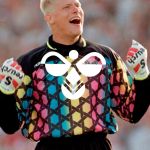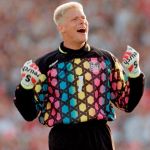
Let's start with a simple statement: if you are a sports brand known mostly for being the official technical sponsor of Denmark, a national football team that with regards to both their male and female selection has players who are closer to being models that "simple” footballers, then style and creativity cannot just be an option.
Hummel has not had it repeated twice, and in the last twenty years, the brand has adopted an interesting strategy that is mixing streetwear, football high-profile design and philanthropic marketing that made us fall in love with the northern style.
Let's start from the beginning
Not everyone knows that Hummel is not danish, the company was founded in Germany, in Hamburg, in 1923. Although they have a special relationship with Denmark since 1975.
Born to dress football and handball, in the post-war period it became the third power in northern Europe for sportswear (after adidas and PUMA) but it’s really since the eighties that it has developed the style that has identified it as a cult brand over time. Two elements, almost always imperative: the geometric logo representing a stylized bumblebee and the staple on the sleeves, often taken on the shorts.
Hummel's work has always proceeded on two parallel tracks. On one hand, they joined partnerships with some of the most famous teams in the world, on the other they have never stopped producing and supporting medium-small or microscopic realities, sometimes almost at the limit of the absurd (and not only in the world of football).

In the first category, we can certainly include the many years as a technical sponsor of the national team of Denmark, a relationship born in 1979 and continued until 2004, culminating in the incredible and unexpected victory at the European Championship in 1992 by the Danish team. A report was taken up only recently, in 2016: a winning combination (for style, rather than sports results) also in these last world championships in Russia, where the kit designed for the occasion was certainly among the most elegant and pleasant of the competition.
Again with regard to the "great stories" we can not fail to mention the years in which the characteristic Hummel logo was imprinted on the shirts of Real Madrid, from 1986 to the early nineties, years in which the Blancos managed to ascend the throne of Spain after a six-year fast, winning five consecutive home titles.

Always together with outsiders
But the work in which Hummel has always stood out, often letting go the power of imagination, is certainly that for smaller teams and above all in support of humanitarian causes.
For example, the German/Danish brand in 2001 became a supporter and technical sponsor of the Tibetan national team, not recognized by FIFA and AFC mainly due to China, organizing a match against Greenland on the Danish soil. In 2016 Hummel, together with Khalida Popal, a footballer and activist, designed the first kit of the history for the Afghan national football team, both male and female, with the significant inclusion of the hijab in the design of the female kit, a very curated one, embellished with geometric patterns on the sleeves and at the hem of the shirt. Since 2012 Hummel has also been the technical sponsor of Christiania FC, the football club of the Copenhagen district of the same name, founded in 1971 and self-appointed "a self-governing squat community"; a place at the limits of legend, between anarchist inspirations, drugs, art and crime, for which the brand has thought a whole line of well-kept clothing, an attempt to reflect the history and environment of Christiania.
The last project in temporal order, among thousands of others that I am now leaving behind, was launched in view of the Russian world championships, accompanied by their slogan "CHANGE THE WORLD THROUGH SPORT": to raise money for the Russian LGBT Sport Federation, Hummel has put up for sale six shirts each one of a color of the rainbow flag, symbol of the movement, and with the Russian writing "Change The World" on the chest. As for that vein of light madness, always present in the brand, we can not talk about the kit made for the SCR Peña Deportiva, the football team of Ibiza: it is almost indescribable in words, you should take a look at it yourself.
Marketing with a golden heart
This well-defined philosophy of the brand summarized perfectly by the before mentioned slogan, has actually emerged since 1999, when Christian Stadil took over the reins of the company, and definitively raised the fortunes after the bankruptcy of a few years earlier. Stadil is the creator of the Company Karma business model, which aims to promote change through sport in some of the most disadvantaged places in the world. Spreading for a moment the discourse outside the exclusive and very special Hummel world, these days Nike also has raised attention in this sense, choosing as testimonial for the thirty years of the "Just Do It" campaign that Colin Kaepernick that became a symbol of civil rights, of the Black Lives Matters and anti-Trump movement. In short, it seems that this model of brand-activism is increasingly affirming and seems to be only at the beginning: it will be interesting to observe future developments. However, it is important to remember that in this sense, Hummel has been at the cutting edge and forefront for about twenty years now.
The world's biggest rainbow football jersey - made out of football jerseys - is in the making.
— hummel (@hummel1923) 21 giugno 2018
Stay tuned...#ChangeTheWorldThroughSport pic.twitter.com/lyZQv04FnE
From football to streetstyle
Over the years Hummel's style has followed an organic evolution, without jolts or risky choices but rather very coherent, while not exempting itself from exploits of pure creativity. The first line of sportswear dates back to 1969, and since then it has always emerged in a distinct way a typically Northern European taste for the "clean" and classy designs but often embellished with colorful patterns to give them a touch of unprecedented vitality, almost unexpected.
It has always been since 1999 and even more so since 2013 (the year in which the company celebrated its ninetieth year of life) that Hummel has approached the world of street style in a much more conscious and decisive way, undertaking a backward journey of recovery and enhancement of its tradition, in line with what is happening in the world of sportswear and even to Italian brands that can be equated, like Kappa or Diadora.

The last most interesting projects in temporal order certainly are the collaboration with the Scottish sneaker shop Hanon, a very interesting tribute to Scottish football of its minor leagues, with three different packs (sneakers plus t-shirt) inspired by as many militant clubs in the Scottish Highland League: Huntly FC , Forres Mechanics FC and Rothes FC. For the project, Hummel also relied on the renowned sports photographer Brian Sweeney, author of the incredibly evocative shots of the campaign.
As for pure nostalgia, Hummel has recently revived the explosive fantasy of the goalkeeper kit worn by the legendary Peter Schmeichel during the winning ride of Denmark to the Europeans of '92: hypnotizing geometric fantasy and neon colors for the long sleeve and adapted to two different pairs of sneakers.

To try and enter the fashion world, Hummel collaborated with the New York designer Willy Chavarria presenting a collection on July 9th at the New York Fashion Week, as usual linking the collaboration to a broader social project, to support the regular or non-regular immigrant players of the big apple; all with special consideration for the Mexican and Latin American community, where the origins of Chavarria come from.
Hummel is a cult brand for football fans, but through an admirable company marketing policy and contemporary and even pleasantly retro stylistic ideas, it has the potential to grow exponentially in the near future. We have definitely been conquered, and we can not wait to find out what will await us the future from one of craziest and creative brands of the moment.









































.png)


.jpg)





















